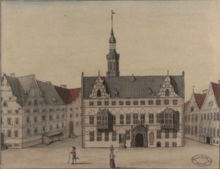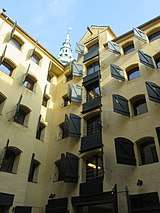Ploug House
| Ploug House | |
|---|---|
| Plougs Gård | |
.jpg) Ploug House with the spire of the former St. Nicolas' Church in the background | |
| General information | |
| Architectural style | Neoclassical |
| Location | Copenhagen, Denmark |
| Country | Denmark |
| Construction started | 1798 |
| Completed | 1799 |
| Client | C. F. Friderici |
| Design and construction | |
| Architect | Andreas Hallander |
Ploug House (Danish Plougs Gård) is a listed Neoclassical property on the corner of Højbro Plads and Ved Stranden in central Copenhagen, Denmark. It dates from the building boom which followed after the Copenhagen Fire of 1795 but takes its name after the poet, publisher and politician Carl Ploug who lived there in the 1860s and 1870s and also published his magazine Fædrelandet from the premises.
History
Rarly history

Christian IV's mother-in-lae Ellen Marsvin constructed a large, Renaissance style house at the site in the 17th century. It was used for housing the Swedish military officer Magnus Stenbock during his five years in Danish captivity. The Marsvin House was destroyed in the Copenhagen Fire of 1795 along with most of the other buildings in the area.
The current building at the site was constructed on the foundation of the old house in 1798–99 by Andreas Hallander for C. F. Friderici, a wealthy merchant.[1]
The anatomist Herman Treschow Gartner (1785-1827) lived in the building in 1823-24. J. D. Brandis (1762-1845), Queen Maria Sophie's physician, resided there until 1829.
The Melchiors and H. C. Andersen

.jpg)
Moritz G. Melchior, the owner of Moses & Søn G. Melchior, acquired the building in 1855. He lived with his family on the second floor and also ran his company from the premises. The Melchior family were among Hans Christian Andersen's closest friends. He stayed with the family from 13 March until 21 May 1870 in their residence on Højbro Plads, where he wrote What the Whole Family Said,[2] and the Melchiors also hosted the celebration of his 70th birthday. He spent his last year at Melchior's country house Rolighed in Østerbro where he died on 4 August 1875. Melchior's unmarried daughter Louise Melchior continued to live in the house until her death in 1934.[1]
Carl Ploug and later history
.jpg)
The poet and politician Carl Ploug purchased the building from Melchior in 1862. He published his magazine Fædrelandet ("The Fatherland") from the address and also had his home in the house. His family owned the property for more than 50 years.[1]
Architecture


The house is designed in the Neoclassical style. It consists of four storeys and a cellar and has six bays towards Højbro Plads and seven towards Ved Stranden. The facade is decorated with pilasters. The "bevel" corner is typical for the buildings of the period, being a requirement under the new building regulations to facilitate the fire corps' passage through the city in the event of fire.[3]
Today
The complex consists of a combination of offices and housing. Vica Wood, a manufacturer of flooring, is based at No. 21 B.
See also
References
- 1 2 3 "Ved Stranden 20 / Højbro Plads 21-21a-b" (in Danish). indenforvoldene.dk. Retrieved 2012-09-15.
- ↑ "Højbro Plads og H.C.Andersen" (in Danish). H. C. Andersen Information. Archived from the original on 20 November 2007. Retrieved 16 September 2012.
- ↑ "Københavns brande" (in Danish). Gyldendal. Retrieved 2012-09-16.
External links
| Wikimedia Commons has media related to Plougs Gård. |